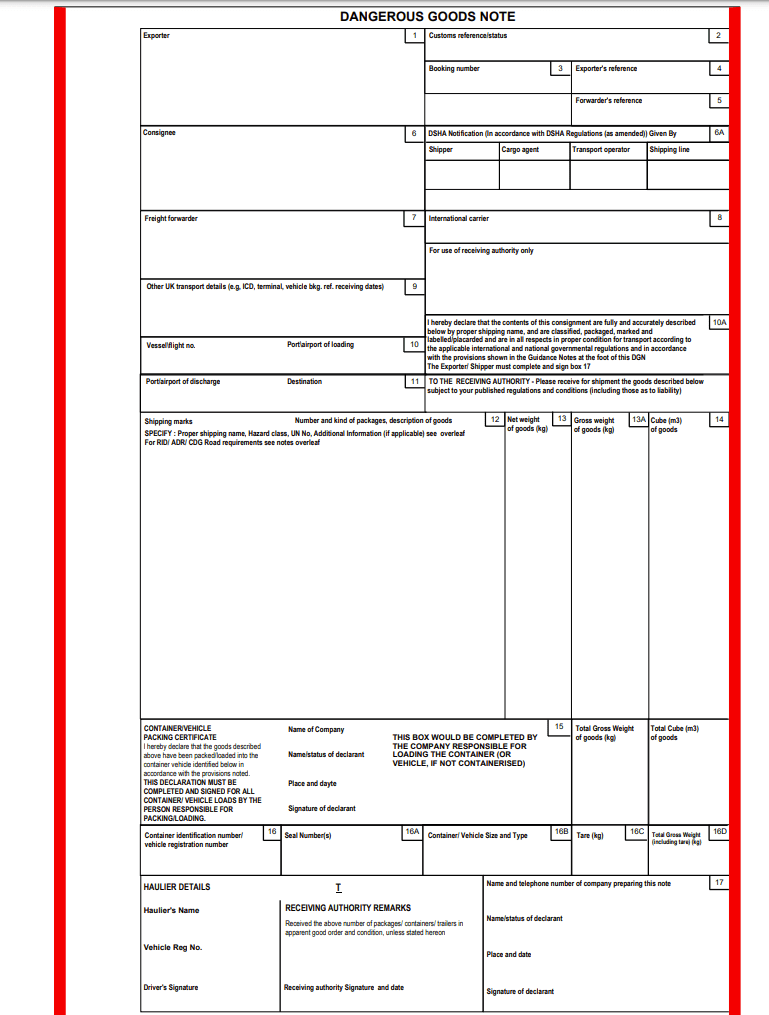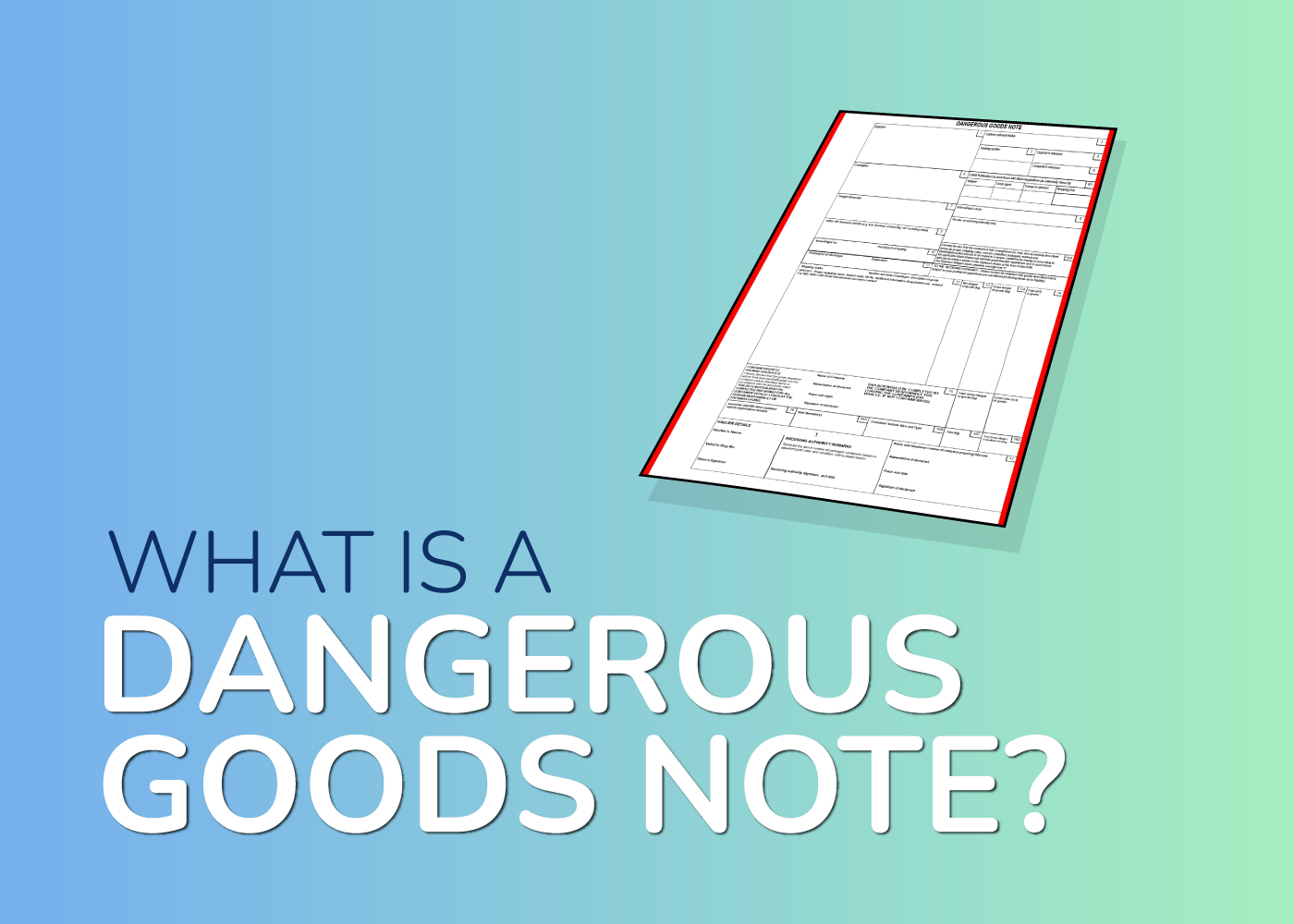What is a Dangerous Goods Note (DGN)?
A Dangerous Goods Note (DGN) is a critical shipping document utilized in international trade to ensure the safe handling and transport of cargo classified as hazardous or dangerous. According to the UN Model Regulations, these goods fall under the Dangerous Goods Emergency Action Code List (EAC), which outlines the protocols for their safe management. The DGN serves as a vital tool in mitigating risks associated with transporting dangerous goods, ensuring compliance with international safety standards.

Download Dangerous Goods Note (DGN) Form
When is a Dangerous Goods Note (DGN) Used?
The creation of a DGN is mandatory when shipping dangerous goods overseas. If the goods in question are not classified as dangerous, a Standard Shipping Note (SSN) should be created instead. The DGN is specifically tailored for two primary modes of transport:
- Surface Transport: A DGN is required for surface shipments, including road and rail.
- Air Transport: For air shipments, an IATA Dangerous Goods Declaration is necessary, highlighting the unique regulations governing air freight.
In situations where dangerous goods may be spilled, exposed, or unpacked, resulting in potential hazards to people, wildlife, or the environment, a DGN must accompany the shipment. For instance, flammable liquids, such as whiskey and certain wines and spirits, are categorized as explosive risks and require a Dangerous Goods Note to be shipped legally and safely.
Why Do I Need a DGN?
The necessity of a Dangerous Goods Note extends beyond mere compliance; it serves several crucial functions:
- Informing Logistics and Freighting Companies: The DGN provides essential information to logistics providers on how to handle, store, and transport hazardous goods effectively.
- Notifying Port Authorities: Port authorities must be aware of the hazardous nature of the cargo to ensure appropriate safety measures are in place during unloading and storage.
- Guiding Customs and Receiving Authorities: Customs officials and receiving authorities rely on the DGN to treat the cargo appropriately, ensuring compliance with regulatory requirements.
- Assisting Emergency Services: In the event of an accident or spill, emergency services require information about the dangerous nature of the goods to implement the correct response measures.
Moreover, utilizing a DGN can offer significant financial incentives. By pre-informing the necessary parties about the dangerous nature of the cargo, businesses can streamline processing times, avoid costly delays, and reduce the likelihood of accidents that may incur additional expenses.
Financial incentive in using a DGN
Having a DGN has a financial incentive, because informing or pre-informing the necessary parties of the dangerous nature of your cargo, will save you time and money in processing your goods.
Where can I get a DGN template document?
You can get your logistics firm or freight forwarder to provide you with a blank template of the Dangerous Goods Note form. Just make sure it’s in the UN-aligned format. Alternatively, click here for a free UN-aligned DGN template.
Additionally, you can use an online solution such as edgectp.com to help you generate paper and electronic versions, just remember to use the free 30-day trial to see how you get on first.
Conclusion
In conclusion, a Dangerous Goods Note (DGN) is an indispensable document in the realm of international trade, particularly when dealing with hazardous materials. It plays a pivotal role in ensuring the safety and compliance of shipping operations, protecting not only the shipment but also the people and environments that may be impacted. Understanding when and how to use a DGN is crucial for any business involved in the transport of dangerous goods, as it fosters safety, efficiency, and regulatory compliance while also offering financial benefits. As the landscape of international trade continues to evolve, ensuring proper documentation and adherence to safety protocols remains a top priority for successful logistics management.
FAQs (Frequently Asked Questions)
What is a dangerous goods note?
A dangerous goods note is a form that needs to be filled out by individuals or businesses who are exporting dangerous goods.
What is a DGN?
DGN stands for Dangerous Goods Note. It is also referred to as DGD which stands for Dangerous Goods Declaration.
Do I need a dangerous goods note?
If you ship any substance or material capable of causing a risk to someone’s health, safety, or property for commercial purposes, you need to accurately complete a dangerous goods note (DGN).
What is dangerous goods labelling?
Dangerous goods labels provide information about the specific risks associated with the contents of a dangerous goods package.
Who completes a dangerous goods note?
The shipper of dangerous goods is responsible for accurately completing a dangerous goods note.

